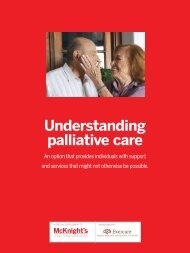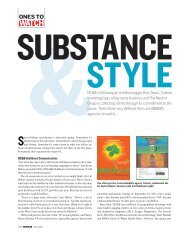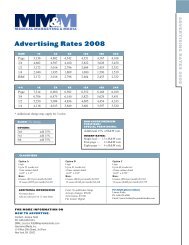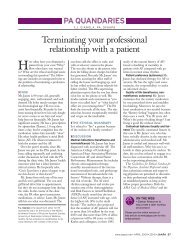Review - Haymarket Media Group
Review - Haymarket Media Group
Review - Haymarket Media Group
Create successful ePaper yourself
Turn your PDF publications into a flip-book with our unique Google optimized e-Paper software.
Figure<br />
Paclitaxel 175 mg/m2<br />
every 21 days for 4 doses<br />
n=1253<br />
Randomization scheme.<br />
Trial Design<br />
Eligible patients had operable, histologically confirmed<br />
adenocarcinoma of the breast with histologically<br />
involved lymph nodes (tumor stage T1, T2, or<br />
T3 and nodal stage N1 or N2) or high-risk, axillary<br />
lymph node–negative disease (T2 or T3, N0) without<br />
distant metastases. Adequate organ function was<br />
required. Exclusion criteria included history of<br />
myocardial infarction, congestive heart failure, heart<br />
disease, pregnancy, or history of hypersensitivity<br />
reaction to paclitaxel or docetaxel. Full inclusion and<br />
exclusion criteria can be found online in the supplementary<br />
appendix of the original article.<br />
A total of 5052 patients were enrolled, of whom<br />
4950 (98%) were eligible. All patients received doxorubicin<br />
(60 mg/m 2 of body surface area) and<br />
cyclophosphamide (600 mg/m 2 of body surface area)<br />
every 3 weeks for four cycles. Patients were then randomized<br />
to one of four treatment arms (Figure).<br />
Women who had breast-sparing surgery received<br />
radiotherapy according to accepted standards of care,<br />
and patients who had a modified radical mastectomy<br />
received radiotherapy at the discretion of the treating<br />
physician. All women with hormone receptor–<br />
positive disease received tamoxifen 20 mg daily for 5<br />
years. The protocol was modified in 2005 to allow for<br />
a change to an aromatase inhibitor prior to completion<br />
of 5 years of tamoxifen or to begin an aromatase<br />
inhibitor after completing 5 years of tamoxifen.<br />
Operable breast cancer,<br />
lymph node positive or high-risk node negative<br />
N=4950<br />
Doxorubicin 60 mg/m 2 +<br />
cyclophosphamide 600 mg/m2<br />
every 21 days for 4 cycles<br />
Paclitaxel 80 mg/m2<br />
weekly for 12 doses<br />
n=1231<br />
Docetaxel 100 mg/m2<br />
every 21 days for 4 doses<br />
n=1236<br />
Weekly paclitaxel and breast cancer<br />
Docetaxel 35 mg/m2<br />
every 21 days for 12 doses<br />
n=1230<br />
The primary end point of the study was diseasefree<br />
survival, which was defined as the time from<br />
randomization to disease recurrence and included<br />
death from recurrence, death without recurrence,<br />
and contralateral breast cancer. The study had 86%<br />
power to detect a 17.5% reduction in the hazard<br />
rate for failure among the docetaxel groups or with<br />
weekly instead of every-3-week dosing. All eligi-<br />
The primary end point<br />
of the study was<br />
disease-free survival.<br />
ble patients undergoing randomization were<br />
included in the efficacy analysis, and all treated<br />
patients were included in the adverse events<br />
analysis. The log-rank test was used for analysis<br />
of disease-free and overall survival. Kaplan-Meier<br />
analysis was used to estimate distributions of<br />
events with respect to time. Cox proportional hazards<br />
models were used to estimate hazard ratios<br />
November 2008 • Vol 7 • Supplement 5 11
















